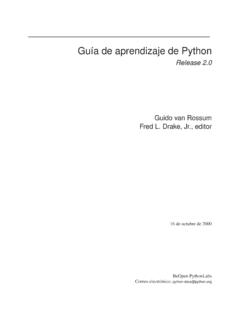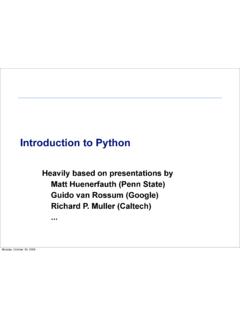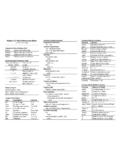Transcription of Hands-on Python Tutorial - Loyola University Chicago
1 Hands-on Python Tutorial Release for Python Version +. Dr. Andrew N. Harrington, Loyola University Chicago March 06, 2015. CONTENTS. 1 Beginning With Python 1. Context .. 1. The Python Interpreter and Idle, Part I .. 6. Whirlwind Introduction To Types and Functions .. 12. Integer Arithmetic .. 14. Strings, Part I .. 15. Variables and Assignment .. 17. Print Function, Part I .. 19. Strings Part II .. 20. The Idle Editor and Execution .. 20. Input and Output .. 23. Defining Functions of your Own .. 28. Dictionaries .. 41. Loops and Sequences .. 45. Decimals, Floats, and Floating Point Arithmetic .. 59. Summary .. 62. 2 Objects and Methods 71. Strings, Part III .. 71. More Classes and Methods .. 78. Mad Libs Revisited .. 80. Graphics .. 86. Files .. 112. Summary .. 115. 3 More On Flow of Control 119. If Statements.
2 119. Loops and Tuples .. 136. While Statements .. 141. Arbitrary Types Treated As Boolean .. 155. Further Topics to Consider .. 158. Summary .. 158. 4 Dynamic Web Pages 163. Overview .. 163. Web page Basics .. 164. Composing Web Pages in Python .. 166. CGI - Dynamic Web Pages .. 170. Summary .. 179. Index 183. i ii CHAPTER. ONE. BEGINNING WITH Python . Released under the Creative commons Attribution-Noncommercial-Share Alike United States License Context You have probably used computers to do all sorts of useful and interesting things. In each application, the computer responds in different ways to your input, from the keyboard, mouse or a file. Still the underlying operations are determined by the design of the program you are given. In this set of tutorials you will learn to write your own computer programs, so you can give the computer instructions to react in the way you want.
3 Low-Level and High-Level Computer Operations First let us place Python programming in the context of the computer hardware. At the most fundamental level in the computer there are instructions built into the hardware. These are very simple instructions, peculiar to the hardware of your particular type of computer. The instructions are designed to be simple for the hardware to execute, not for humans to follow. The earliest programming was done with such instructions. If was difficult and error-prone. A. major advance was the development of higher-level languages and translators for them. Higher-level languages allow computer programmers to write instructions in a format that is easier for humans to understand. For example z = x+y is an instruction in many high-level languages that means something like: 1.
4 Access the value stored at a location labeled x 2. Calculate the sum of this value and the value stored at a location labeled y 3. Store the result in a location labeled z. No computer understands the high-level instruction directly; it is not in machine language. A special program must first translate instructions like this one into machine language. This one high-level instruction might be translated into a sequence of three machine language instructions corresponding to the three step description above: 0000010010000001. 0000000010000010. 0000010110000011. Obviously high-level languages were a great advance in clarity! If you follow a broad introduction to computing, you will learn more about the layers that connect low-level digital computer circuits to high-level languages. 1. Hands-on Python Tutorial , Release for Python Version +.
5 Why Python There are many high-level languages. The language you will be learning is Python . Python is one of the easiest languages to learn and use, while at the same time being very powerful: It is used by many of the most highly productive professional programmers. A few of the places that use Python extensively are Google, the New York Stock Exchange, Industrial Light and Magic, .. Also Python is a free language! If you have your own computer, you can download it from the Obtaining Python for Your Computer Even if you have Python on your own computer, you may well not have the latest version. Go to the Downloads page below and check on the latest version. The instructions for individual operating systems describe how to check if you think you already have what you need. Go to the Downloads page linked to Be careful to choose the version for your operating system and hardware.
6 Choose the latest stable version. You do not need a source code distribution. Do not choose a version , which is incompatible. (Version and are described in an older version of this Tutorial .). Windows If you think you already have a current Python set to go, you can check by getting the examples, Your Python Folder and Python Examples (page 6). Then try starting Idle: Starting Idle (page 10). If Idle starts, see if the version matches the latest version of Python . If so, skip the part below! Note: there is one variation from the default installation below: Read everything before completing the installa- tion. Make sure the version is at least or later, and use a download package with the MSI installer, if it is available. If you do not know that your machine is using a 64 bit version of the operating system, a 32 bit version is safer.
7 Except in one case, you just need to execute the installer, and interact enough to agree to all the default choices: On the step choosing components to install, if there is an X beside the last component, putting Python in your path, you are encouraged to click on that component and include it. If you forget this one variation from the defaults, you can return to the installation and repair it. OS X If you think you already have a current Python set to go, then try starting Idle: Starting Idle (page 10). If Idle starts, see if the version matches the latest version of Python . If so, skip the part below! Double-click on the installer for your version of OS X. Find and run the that is inside. Follow the defaults for installation. Note that Python uses a Tcl/Tk library, and Macs come with a version, however, for some versions of the operating system, a different version of Tcl/Tk is needed.
8 Be sure to see http: and see if you need to do a separate download listed there. Linux An older version of Python is generally installed, and even if a current version, +, is installed, Idle is not always installed. Look for a package to install, something like idle- Python ' (the name in the Ubuntu distribution). Philosophy and Implementation of the Hands-on Python tutorials Although Python is a high-level language, it is not English or some other natural human language. The Python translator does not understand add the numbers two and three . Python is a formal language with its own specific rules and formats, which these tutorials will introduce gradually, at a pace intended for a beginner. These tutorials are also appropriate for beginners because they gradually introduce fundamental logical programming skills.
9 Learning these skills will allow you to much more easily program in other languages besides Python . Some of the skills you will learn are 2 Chapter 1. Beginning With Python Hands-on Python Tutorial , Release for Python Version +. breaking down problems into manageable parts building up creative solutions making sure the solutions are clear for humans making sure the solutions also work correctly on the computer. Guiding Principals for the Hands-on Python tutorials : The best way to learn is by active participation. Information is principally introduced in small quantities, where your active participation, experiencing Python , is assumed. In many place you will only be able to see what Python does by doing it yourself (in a Hands-on fashion). The Tutorial will often not show. Among the most common and important words in the Tutorial are Try this.
10 Other requests are for more creative responses. Sometimes there are Hints, which end up as hyperlinks in the web page version, and footnote references in the pdf version. Both formats should encourage you to think actively about your response first before looking up the hint. The tutorials also provide labeled exercises, for further practice, without immediate answers provided. The exercises are labeled at three levels No label Immediate reinforcement of basic ideas - preferably do on your first pass. * Important and more substantial - be sure you can end up doing these. Allow time to do them! ** Most creative Information is introduced in an order that gives you what you need as soon as possible. The information is presented in context. Complexity and intricacy that is not immediately needed is delayed until later, when you are more experienced.








